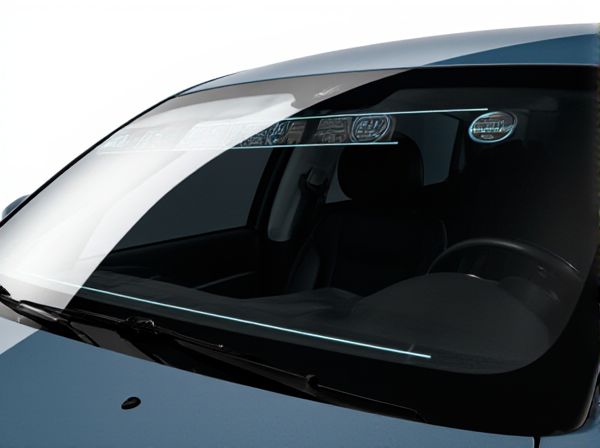
Photo illustration: HUD-Compatible vs Non-Compatible Windshield
A HUD-compatible windshield is engineered with special coatings and optical properties to ensure clear visibility of the heads-up display, preventing distortion and glare that can hinder your view. Non-compatible windshields lack these features, often causing image blurring or ghosting, negatively impacting the effectiveness of the HUD system. Choosing a HUD-compatible windshield enhances safety and ensures optimal performance of your vehicle's display technology.
Table of Comparison
| Feature | HUD-Compatible Windshield | Non-Compatible Windshield |
|---|---|---|
| Visibility | Clear and distortion-free HUD display | Distorted or unclear HUD images |
| Material | Special optical coating for reflection clarity | Standard glass without optical enhancements |
| HUD Integration | Optimized for head-up display projects | Not designed for HUD compatibility |
| Driver Safety | Enhanced focus and reduced distraction | Potential increased distraction due to glare |
| Price Impact | Higher cost due to advanced material | Lower cost standard option |
| Use Case | Vehicles equipped with HUD technology | Vehicles without HUD systems |
Understanding HUD-Compatible Windshields
HUD-compatible windshields are designed with a special coating or layer that optimizes the reflection and clarity of head-up display (HUD) images, ensuring drivers can easily view critical information without distortion or glare. These windshields use a specific glass composition and curvature to maintain image sharpness and prevent double images, which are common with non-compatible windshields. Understanding the difference is crucial for vehicle owners who rely on HUD technology for navigation, speed, and safety alerts, as non-compatible windshields can significantly reduce HUD effectiveness.
What Defines a Non-Compatible Windshield?
A non-compatible windshield for HUD (Head-Up Display) lacks the specialized coatings or optical properties needed to properly reflect the display images, causing distortion or reduced visibility. These windshields often have tinting, curvature, or laminated layers that interfere with the HUD's light projection and clarity. Vehicles with non-compatible windshields experience diminished HUD performance, making it difficult for drivers to view critical information clearly on the windshield surface.
Key Differences Between HUD-Compatible and Non-Compatible Windshields
HUD-compatible windshields feature a specialized reflective coating enabling clear projection of heads-up display information without distortion or glare, optimizing driver visibility and safety. Non-compatible windshields lack this coating, causing HUD images to appear blurry, double, or less visible, which can impair quick information recognition. Material composition and curvature precision in HUD-compatible glass are engineered to enhance display clarity, while standard windshields prioritize general transparency without HUD-specific enhancements.
How HUD Technology Enhances Driving Experience
HUD-compatible windshields are specifically designed with special coatings or materials that allow heads-up display (HUD) technology to project clear, vibrant images directly onto the glass without distortion. This enhancement provides drivers with critical information such as speed, navigation, and safety alerts in their line of sight, reducing the need to glance away from the road. In contrast, non-compatible windshields can cause glare or blurry HUD visuals, impairing the driving experience and potentially compromising safety.
Installation Requirements for HUD-Compatible Windshields
HUD-compatible windshields require precise installation with calibrated mounting points to ensure accurate heads-up display (HUD) projections. Specialized adhesives and sensors integration are essential to maintain the functionality and clarity of the HUD system. Incorrect installation can cause distortion or misalignment of the HUD images, affecting driver visibility and safety.
Cost Comparison: HUD-Compatible vs Non-Compatible Windshields
HUD-compatible windshields typically cost 20% to 40% more than non-compatible versions due to integrated sensors and special coatings required for heads-up display functionality. Replacement expenses for HUD-compatible windshields often include recalibration fees, increasing the total cost by approximately $200 to $500 compared to standard windshield replacements. Non-compatible windshields, lacking these advanced features, generally have lower material and labor costs, making them a more economical choice for vehicles without HUD systems.
Safety Implications of Each Windshield Type
HUD-compatible windshields are designed with an optical coating that ensures clear projection of heads-up display images, enhancing driver focus and reducing eye strain, which directly contributes to safer driving. Non-compatible windshields lack this specialized coating, often causing distortion or reduced visibility of HUD information, potentially distracting the driver and increasing the risk of accidents. Choosing a HUD-compatible windshield supports optimal safety by maintaining the integrity of critical visual data essential for timely decision-making on the road.
Maintenance and Durability Factors
HUD-compatible windshields incorporate specialized coatings and precise glass thickness to ensure optimal projector clarity and durability against wear, resulting in easier maintenance and longer lifespan in vehicles equipped with head-up displays. Non-compatible windshields lack these features, often leading to quicker degradation under environmental stress and more frequent replacement or repair due to compromised visibility and structural integrity. Choosing a HUD-compatible windshield enhances maintenance efficiency and durability, reducing long-term costs associated with windshield wear and HUD performance.
Upgrading: Can You Switch Between HUD and Non-HUD Windshields?
Upgrading from a non-HUD to a HUD-compatible windshield requires precise alignment to ensure the heads-up display projects accurately onto the glass, making direct switching between HUD and non-HUD windshields complex. HUD-compatible windshields are specially designed with reflective coatings and curvature optimized for clear display visibility, which non-HUD windshields lack. Successful HUD upgrades often necessitate professional installation and calibration to maintain display clarity and driver safety.
Choosing the Right Windshield for Your Vehicle
Choosing the right windshield for your vehicle hinges on compatibility with your Head-Up Display (HUD) system, ensuring clear projection visibility and optimal safety. HUD-compatible windshields feature special coatings and precise glass layers designed to prevent image distortion and reflections. Non-compatible windshields may compromise HUD functionality, causing blurred or misaligned displays that can distract drivers and reduce situational awareness.
 caratoz.com
caratoz.com